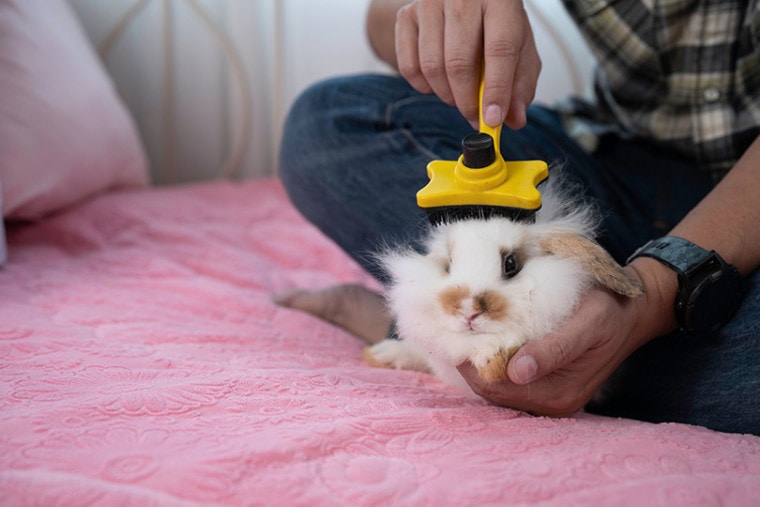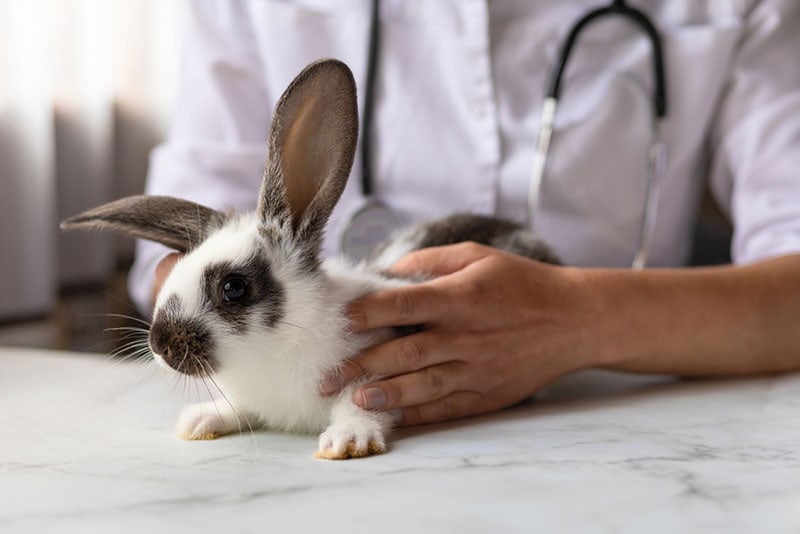
Almost every rabbit sheds at least a little. This process is completely natural and occurs throughout the year, due to seasonal, hormonal, and environmental factors. Rabbits will groom themselves while they shed, which can cause them to ingest some of their fur. While this is normally natural and completely fine, it can sometimes lead to digestive issues.
However, rabbits can shed excessively, as well. Not all shedding is completely normal. It can be made worse by a range of features, often caused by overgrooming, including stress, boredom, pain, illness, parasites, and poor grooming. Below, we’ll take a careful look at all of these factors.
If your rabbit has patches of fur loss, skin changes, irritation, itchinnes, furmats, or any other signs of skin or generalized illness, it’s important to speak to your vet as soon as possible.

The 9 Reasons Why Your Rabbit Is Shedding So Much
1. Seasonal Changes
Rabbits shed most commonly when the seasons change. Many rabbit breeds have adapted to the environmental temperature changes by growing thicker fur in the winter and thinner fur in the summer. This process allows them to better adapt to their environment and stay at the proper temperature. Some rabbits may shed more often during the entire year or even unrelated to the season, depending on their fur characteristics.
However, in the majority of cases, rabbits will shed and regrow their coat in the spring and fall. Therefore, most rabbits often shed excessively during this time. This process is completely natural and not an indication that anything is wrong. You should groom your rabbit more during these times, though. Long-haired rabbits should be groomed daily or every few days in order to remove excess fur and prevent it getting matted.

2. Hormonal Changes
Rabbits can also undergo a slew of hormonal changes that can affect their shedding. For instance, early growth and development from a young age when their coat changes, pregnancy, and nursing can also trigger changes in shedding. Some female rabbits will even pull fur out in order to prepare a nest prior to giving birth. But even rabbits experiencing false pregnancy may do this.
3. Environmental Factors
Temperature, light, and humidity can also affect how much your rabbit sheds. Indoor rabbits that are regularly exposed to consistent artificial light may shed differently than outdoor rabbits who are more attuned to the natural rhythms of the day and season. Furthermore, low humidity can lead to dry skin in some cases, while high humidity and warm weather may predispose rabbits to skin infection and parasitic infestations, such as fly strike.

4. Stress
Rabbits can become stressed by a range of different factors. Noise, predators, injury, loneliness, boredom, fear, anxiety, pain, aggression and dominance from another rabbit, and changes in routine can all cause serious stress for rabbits. As prey animals, rabbits are more sensitive to stress and changes than many other animals. In the wild, responding to slight changes in the environment allowed them to survive. In our homes, though, it is often less than helpful.
Stress can affect your rabbit in a variety of different ways, causing health issues and leading to excessive shedding or pulling of fur. Sometimes a companion rabbit may pull the other bunny’s fur out as a sign of dominance, boredom, or overgrooming.
5. Boredom
Rabbits are intelligent creatures, and they require physical as well as mental stimulation. When this isn’t provided, they can groom themselves excessively. Simply put, excessive grooming leads to their fur falling out, which can be interpreted as excessive shedding. They may even be seen pulling out their fur (or their cage mate’s fur).
Boredom can also lead to stress, which is another cause of excessive shedding.

6. Improper Grooming
Many rabbit breeds must be groomed regularly to remove excess fur. If you don’t brush your rabbit enough, they can shed all over their hutch and your home. If the fur isn’t brushed properly, the hair just accumulates.
While having rabbit fur all over your home is probably the last thing you want, it can also lead to digestive issues. The excessive fur may be consumed by your rabbit when they groom themselves, leading to a range of digestive problems, including fur balls. Therefore, you should stick to a grooming routine that is appropriate for your rabbit’s breed.
7. Illness
Many health conditions may cause your rabbit to groom less, shed more, or even have patches of fur loss. Some of them are painful joint disease or arthritis, preventing them from grooming or reaching certain body parts, or even dental issues that may cause saliva staining, fur loss, and skin infection around the mouth or eyes. Urinary issues may lead to urine scalding around the urogenital area, sometimes with fur loss. All of these conditions require prompt veterinary care.

8. Skin Conditions
Any sort of skin condition will affect your rabbit’s fur, often making it fall out. When the skin isn’t healthy, the fur often isn’t, either. Mites, fleas, fungal skin infections, wounds, and skin tumors are some of the illnesses associated with fur loss.
These signs often include itching, inflammation, bald patches, malodor, discharge, and scabs. If you believe that your rabbit has a skin condition, taking them to the vet for treatment is the best option. These illnesses can make the rabbit more prone to secondary infections and similar complications.
9. Parasites
Parasites can also cause damage to the fur and skin underneath, leading to fragile fur, hair loss, and bald patches, often accompanied by itchiness. Scratching excessively may lead to skin irritation, crusts, scabs, or even skin wounds in some cases if scratching is getting out of control.
Most common external parasites in rabbits include mites, fleas and lice, while in warmer months fly strike is a genuine concern. Speak to your vet if your bunny has skin issues or they may have parasites, and do not use over-the-counter cat or dog products, as these are not appropriate or safe for rabbits.


Conclusion
All rabbits shed and there isn’t anything you can do to make them quit shedding altogether. It’s a natural process that allows them to keep their coat healthy. However, there are plenty of reasons your rabbit may shed too much. Some of them may involve boredom, stress, anxiety, pain, or underlying health issues, and these should be checked out by the vet.
Featured Image Credit: Wanwajee Weeraphukdee, Shutterstock










